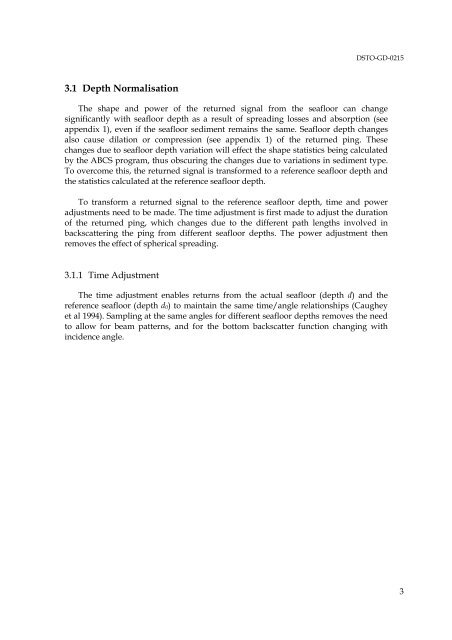The ABCS Program for the Analysis of Echo Sounder Returns for ...
The ABCS Program for the Analysis of Echo Sounder Returns for ...
The ABCS Program for the Analysis of Echo Sounder Returns for ...
Create successful ePaper yourself
Turn your PDF publications into a flip-book with our unique Google optimized e-Paper software.
DSTO-GD-02153.1 Depth Normalisation<strong>The</strong> shape and power <strong>of</strong> <strong>the</strong> returned signal from <strong>the</strong> seafloor can changesignificantly with seafloor depth as a result <strong>of</strong> spreading losses and absorption (seeappendix 1), even if <strong>the</strong> seafloor sediment remains <strong>the</strong> same. Seafloor depth changesalso cause dilation or compression (see appendix 1) <strong>of</strong> <strong>the</strong> returned ping. <strong>The</strong>sechanges due to seafloor depth variation will effect <strong>the</strong> shape statistics being calculatedby <strong>the</strong> <strong>ABCS</strong> program, thus obscuring <strong>the</strong> changes due to variations in sediment type.To overcome this, <strong>the</strong> returned signal is trans<strong>for</strong>med to a reference seafloor depth and<strong>the</strong> statistics calculated at <strong>the</strong> reference seafloor depth.To trans<strong>for</strong>m a returned signal to <strong>the</strong> reference seafloor depth, time and poweradjustments need to be made. <strong>The</strong> time adjustment is first made to adjust <strong>the</strong> duration<strong>of</strong> <strong>the</strong> returned ping, which changes due to <strong>the</strong> different path lengths involved inbackscattering <strong>the</strong> ping from different seafloor depths. <strong>The</strong> power adjustment <strong>the</strong>nremoves <strong>the</strong> effect <strong>of</strong> spherical spreading.3.1.1 Time Adjustment<strong>The</strong> time adjustment enables returns from <strong>the</strong> actual seafloor (depth d) and <strong>the</strong>reference seafloor (depth d 0) to maintain <strong>the</strong> same time/angle relationships (Caugheyet al 1994). Sampling at <strong>the</strong> same angles <strong>for</strong> different seafloor depths removes <strong>the</strong> needto allow <strong>for</strong> beam patterns, and <strong>for</strong> <strong>the</strong> bottom backscatter function changing withincidence angle.3
















